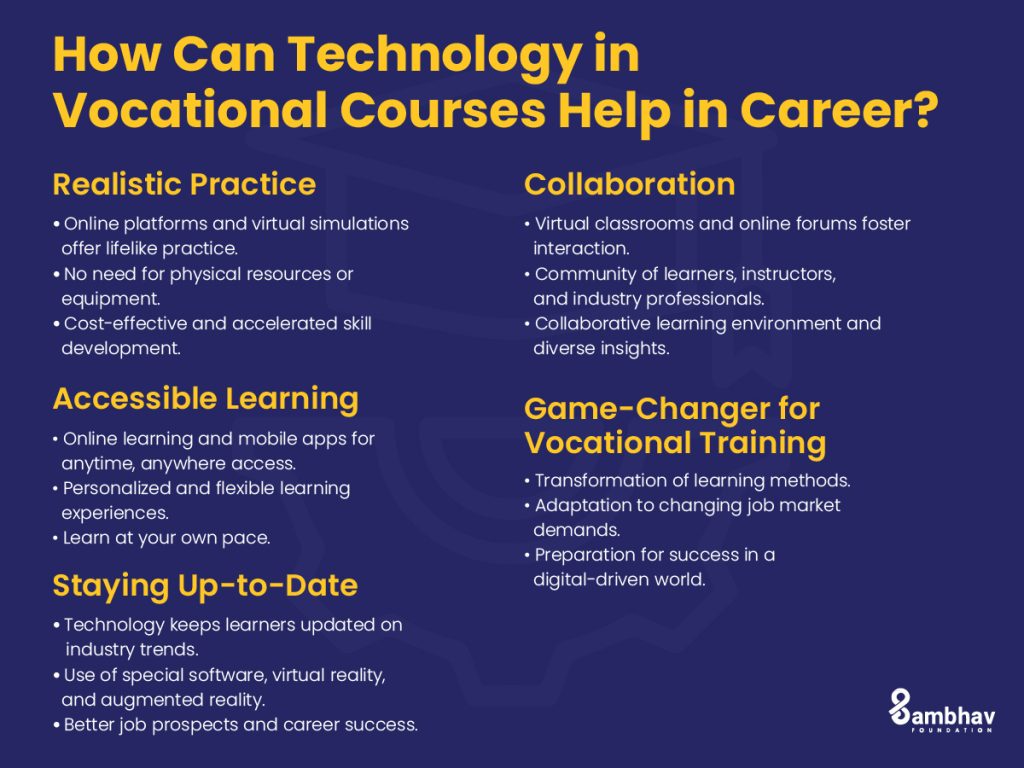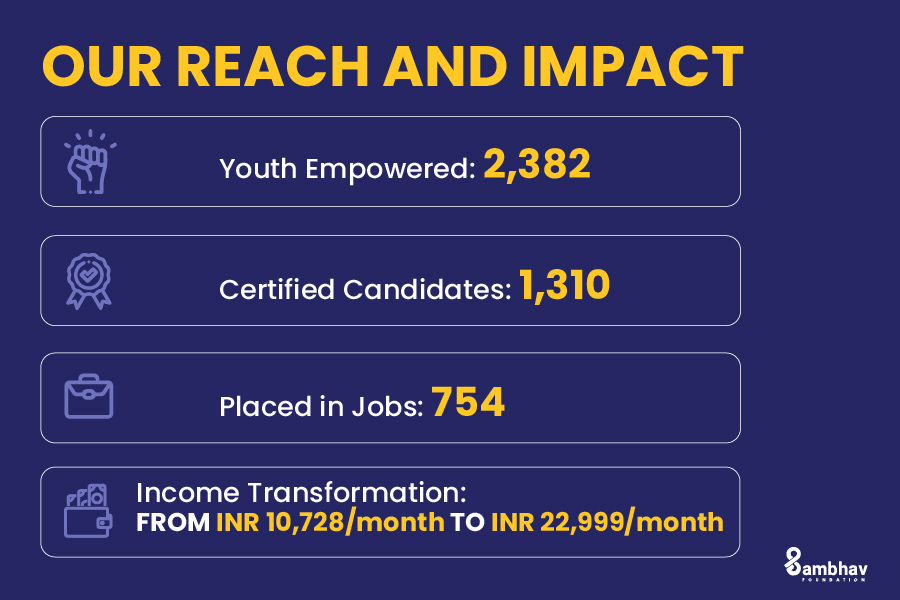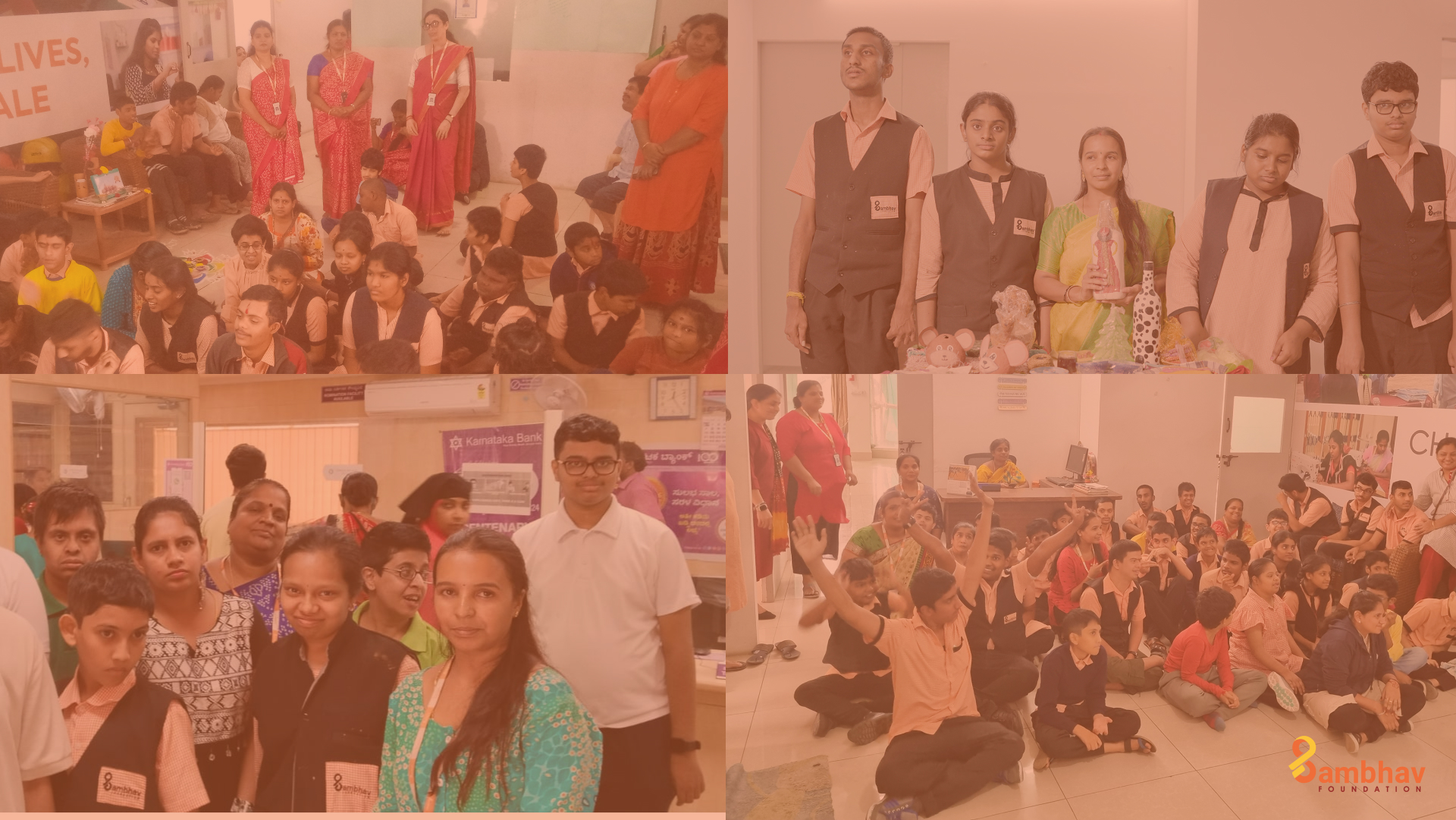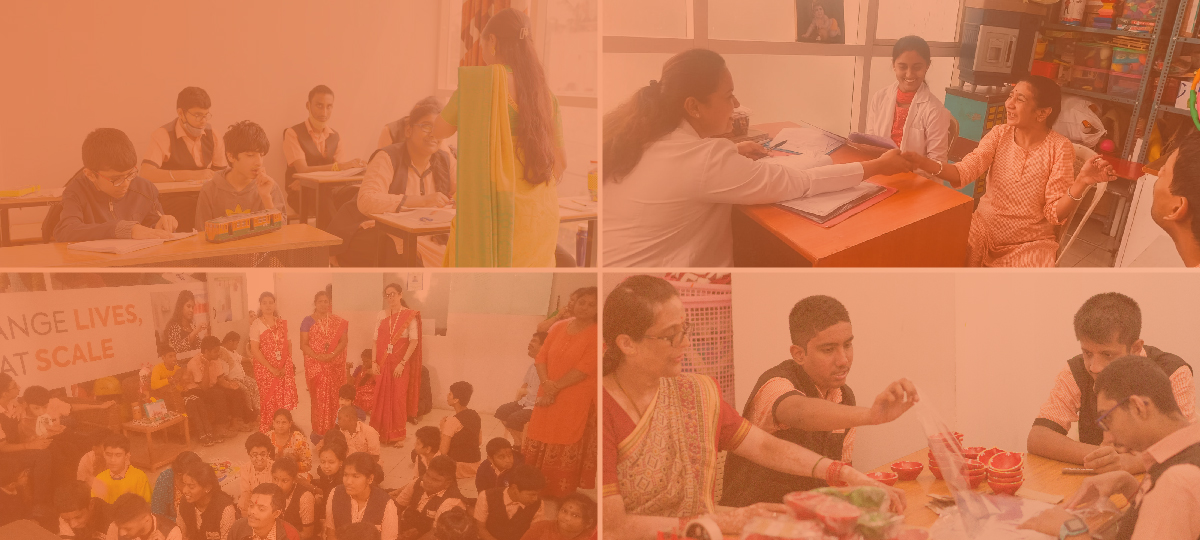Technology in Vocational Courses: Empowering Lives By Unleashing Potential
Vocational courses hold the potential to shape futures and actualize dream professions.
In the continually evolving job marketplace, such courses are becoming pivotal. They empower aspirants with the requisite skills for professional success, with technology playing a pivotal role in vocational education.
In this blog, we explore how technology synergizes with vocational training, but first, a closer look at vocational education is essential to appreciate its significance in career development.
Defining Vocational Education
Vocational education serves as a practical approach towards career readiness, providing individuals with job-specific skills in a streamlined manner. Historically provided by specialized institutes, it has seamlessly integrated into mainstream education and is gaining momentum amongst professionals seeking to enhance their capabilities through practical projects and online courses.
As former Indian Cabinet Minister for Human Resources Development, M. M. Pallam Raju, said, “The Indian youth needs to be empowered, and it can be done through good education and vocational training.
How Does Vocational Training Empower Lives From Skilling to Earning?
Vocational training programs act as catalysts for personal empowerment, equipping individuals with the skills and knowledge essential for flourishing in their chosen fields.
Specialized skills in high-demand fields not only lead to substantial income and financial stability but also boost self-confidence and self-esteem, allowing individuals to find satisfaction and meaning in their work, balancing professional and personal life harmoniously.
When individuals gain specialised skills in fields where there’s a big demand, they can land well-paying jobs and build a stable income for themselves and their families. Financial stability means more control over their life and better choices for their future.
Vocational training also boosts confidence and self-esteem. As someone becomes a professional in their chosen field, they start believing in themselves. This confidence doesn’t just help just at work; it spills over into everything they do.
Why Vocational Training Matters in Today’s Job Market?
In today’s job market, with the dynamic nature of industries and the constant advancements in technology, employers are on the hunt for skilled individuals. And that’s where vocational training steps in.
Vocational training programs help people acquire practical skills and knowledge in specific trades or industries by focusing on hands-on training and teaching technical skills that enable them to excel in their careers.
Vocational training also fosters a sense of confidence and empowerment. Through training, individuals gain a sense of mastery, boosting their self-esteem and sense of purpose.
As the job market evolves, vocational training programs must adapt to meet the changing demands. And this is where technology comes into play. In the next section, we’ll explore how tech supercharges vocational training to enhance the learning experience and empower individuals towards successful careers.

How Can Technology in Vocational Courses Help in Career?
Technology is reshaping the learning landscape in vocational training, offering a plethora of opportunities to learn and develop skills efficiently and effectively through platforms like online learning, virtual reality, and mobile apps, enabling accessible, up-to-date, and collaborative learning experiences.
1. Realistic Practice
One way technology maximises success in vocational training is through online platforms and virtual simulations. These platforms let individuals practise their skills in a lifelike digital world without the need for physical resources or equipment. This saves money and allows them to practise as much as they want, resulting in accelerated skill development.
2. Accessible Learning
Technology has made vocational training accessible to a wider audience. Online learning and mobile apps enable people to access training materials and resources anytime, anywhere, ensuring a personalised and flexible learning experience. No matter where they are, they can learn at their speed.
3. Collaboration
Technology in vocational courses enhances collaboration and communication. Virtual classrooms and online forums facilitate interaction between learners, instructors, and industry professionals, creating a community of support and knowledge-sharing. This fosters a collaborative learning environment and exposes individuals to different perspectives and insights.
4. Staying Up-to-Date
Technology in vocational courses keeps people in touch with what’s happening in their industry. They can use special software, virtual reality, and augmented reality tools to stay on top of the latest advancements. That way, they’re always ready for what employers need, which boosts their chances of finding a job and succeeding in their careers.
In a nutshell, technology in vocational courses is a game-changer. It transforms how we learn and sets us up for success. By embracing technology, vocational training programs can continue to adapt to the changing demands of the job market, preparing individuals to thrive in a digital-driven world.
What is the Role of Technology in Skill Development?
Technology has made it incredibly convenient to learn new skills. People can learn almost anything online, from coding to cooking, at their own pace.
Plus, with personalised learning platforms, they can have a virtual tutor who adapts to their needs. The real-time feedback from quizzes and tests helps in tracking their progress and pinpointing areas for improvement.
And don’t forget about virtual reality – it’s like a hands-on lab for skill-building. Connecting with experts and fellow learners through online communities adds a social touch, and those digital certifications are like real trophies for their skills. Technology makes learning possibilities endless, making skill development more accessible and engaging than ever before.
Sambhav Foundation’s Approach to Technology in Vocational Courses
At Sambhav Foundation, our commitment to innovation is evident in our technological approach to vocational training. We utilise cutting-edge tools and platforms that have proven to be highly effective in skills development.
One of the most remarkable aspects of technology-driven vocational training is its ability to create a sustainable and scalable impact. Sambhav Foundation’s model is not just about today; it’s about securing a better tomorrow. Our programs are designed to expand, reaching more individuals and communities and creating a ripple effect of empowerment.
We are using the power of Virtual Reality (VR) to enhance skill training. VR is like a super cool tool that helps people improve their abilities by providing an interactive and realistic training environment, allowing learners to practise skills, understand complex concepts, and adapt to different work scenarios.
We’ve effectively integrated VR into a variety of training programs, including simulations for industrial paint booths, beauty therapist training, and welding. The truck simulator, for instance, provides a practical experience of handling heavy equipment in a virtual environment, enhancing learners’ understanding and confidence. In our beauty therapist training course, we use this simulation to give learners a virtual experience of a beauty salon, getting them ready for real-world workplace scenarios.
Additionally, in our welding training course, we utilise a semi-immersive environment, allowing learners to safely practise welding techniques before applying them in real-world situations.
Through strategic partnerships with tech companies, we have stayed ahead in the ever-evolving landscape of vocational training. Our initiatives offer
- Short-term and Long-term training
- Technical skill acquisition
- Upskilling opportunities
- Recognition of Prior Learning (RPL)
By harnessing technology in vocational courses, we are bridging the skills gap, promoting equal opportunities, and paving the way for a more inclusive and prosperous society.
Our training centres provide seven types of trade courses, such as
- Automobile Mechanics
- Automotive Assembly Operators
- Fitters
- CNC Operators
- Auto Sales Associates
- Retail Sales Associates
- Beauty Technicians
Moreover, we’re educating those with intellectual disabilities through Saadhya School to help these students gain life skills and vocational expertise.

Blending Tradition and Tech For Women’s Economic Empowerment
In our journey of women’s empowerment, we seamlessly mix tradition and technology in vocational courses. Take our Entrepreneurship Development Program (EDP) for girls as an example—where we use technology platforms to track business transactions while nurturing digital skills. This fusion prepares these young women for a fast-paced world. It has already empowered 207 women to begin working on their dream businesses.
With the combined efforts of our partnerships, rural women are scripting stories of empowerment through beauty and tailoring programs, where they learn skills, find jobs, and improve their incomes and living standards.
Furthermore, armed with skills and business know-how, they have launched their ventures, painting a future where they create their own success stories and positively affect their communities, proving that with support, transformation knows no bounds in empowering women.

What Are the Key Steps That India Can Take To Improve Its Education System?
The 2020 State of Education Report for India, unveiled virtually by UNESCO New Delhi, is about improving education and skills for everyone. It emphasises putting learners first, supporting teachers, and lifelong learning.
The report also highlights the need for vocational education in India and the importance of giving everyone, including women and those with disabilities, access to learning. It’s time to go digital in education and training and protect and promote India’s rich cultural heritage.
By following these ten recommendations, India can move closer to its goals of inclusive and sustainable development:
- Prioritise learners’ aspirations in vocational education and training programs.
- Create a supportive ecosystem for teachers, trainers, and assessors.
- Focus on continuous upskilling, re-skilling, and lifelong learning opportunities.
- Ensure inclusive access to vocational education and training, particularly for women and disadvantaged individuals.
- Accelerate the digitalization of vocational education and training.
- Support local communities in preserving and utilising tangible and intangible cultural heritage for livelihoods.
- Align Technical and Vocational Education and Training (TVET) efforts with the 2030 Agenda for Sustainable Development.
- Explore innovative financing models for TVET programs.
- Expand evidence-based research to enhance planning and monitoring.
- Establish a robust coordination mechanism for inter-ministerial cooperation.
What is the Future of Technology in Vocational Courses in a Digital World?
Vocational education is pivotal for transformative learning, and it’s essential to incorporate advanced technology to ensure its continual relevance and efficiency.
Technology holds the potential to enhance learning experiences remarkably. The integration of virtual reality, augmented reality, and artificial intelligence enables learners to acquire essential skills in an immersive manner. It’s comparable to having a personal mentor within each learning module, fostering both skill mastery and improved problem-solving abilities.
Additionally, technology increases the accessibility of education. With the availability of online platforms and mobile apps, learning can occur at any time, from any location, making education more attainable.
However, it is crucial: Vocational programs need to collaborate with tech specialists and industry leaders to ensure the learning outcomes align with employer needs. Learners are thus prepared to enter the job market with the most current skills and tools, poised to succeed in a constantly changing environment.
Embracing the Role of Technology in Vocational Courses
This blog sheds light on the transformative impact of vocational training on individuals and communities. It illustrates how such training programs equip individuals with the necessary skills for today’s fluid job market.
The discourse also anticipates the role of technology in the future of vocational education. Virtual reality, augmented reality, and artificial intelligence are altering the way learning is experienced, introducing a new dimension of customized education.
Moreover, technology is broadening the accessibility of vocational education. Online platforms and mobile apps allow access to educational resources from anywhere, at any time. This advancement brings education directly to the learner, overcoming geographical constraints.
In closing, vocational training, fueled by technology, breaks barriers, bridges the digital divide, and opens doors to success, no matter who you are or where you come from.
As we journey forward, let’s keep supporting and investing in programs that harness the power of technology, just like the Sambhav Foundation.
At Sambhav Foundation, we make this a reality for everyone by creating an inclusive future driven by technology-powered vocational training.
Visit our website to create a more inclusive tomorrow by supporting technology in vocational courses.




